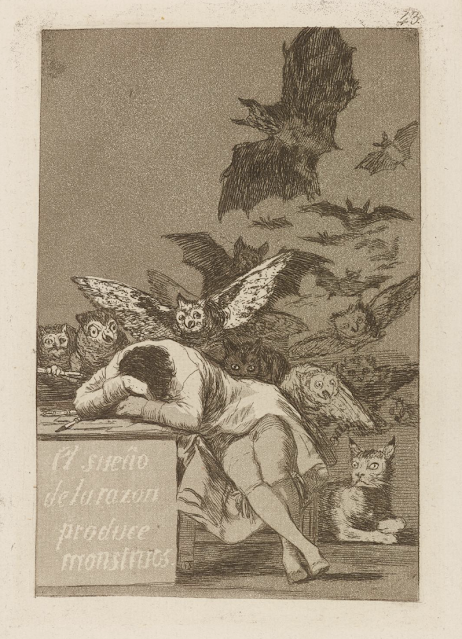 |
| Woodblock print of a horned owl sleeping on a maple branch, 1830s-1840s by Utagawa Hiroshige. |
The owl has been present in human drawings, paintings, and sculptures from the earliest prehistoric cave art to the most modern painters, and shows up in numerous cultures with a wide variety of meanings, sometimes happy, sometimes sinister. I found a number of images on the web that show all sorts of views of owls, some that were mentioned in the book, others not.
 |
Picasso owls from a google search. According to What an Owl Knows, Picasso (1881-1973) became fond of owls because of his pet owl Ubu. |
Leonard Baskin (1922-2000). "Owls" (Philadelphia Museum of Art)
 |
36,000 year-old owl image from the Chauvet Cave in France, (source) |
 |
| Ancient Egyptian owl image. The hieroglyphic for the letter M was an image of an owl. |
 |
Owl on an Athenian coin (480-420 BCE). The owl was a companion of Athena, patron goddess of Athens. (Wikipedia) |
 |
Cochiti potter Juanita Irene Ortiz (1960-2008). "Mapuwana": a storyteller owl. Source: The Owl: A Nuanced Symbol in Native American Cultures |
 |
Kenojuak Ashevak (1927-2013). Preening Owl, 1995. (source) Ashevak was a native of an Inuit village on Baffin Island. She created numerous owl art works. |
"In the Narrangunny (Dreaming story), an Aboriginal woman was sitting at a waterhole fishing for bream. After catching a few fish, she heard a fearsome noise coming from above. Thinking it was the 'devil-devil', she threw everything in the air and ran to her camp screaming. A few of the bravest men were dispatched to investigate the frightening sound, only to find, while checking a small cave above the fishing hole, owls, 'damboyn' sitting in the darkness making their 'mook-mook' call – the sound was merely being amplified by the cave walls."
 |
Francisco Goya (1746-1828). "The Sleep of Reason Produces Monsters." |
 |
| Frans Hals. "Malle Babba," 1633. (Wikipedia) This owl may illustrate the Dutch proverb "Drunk as an Owl." |
.jpeg) |
Cornelis Bloemaert (1603-1692). "The Wise Owl." "What good is candle or glasses when the owl does not wish to see?" |
 |
Hieronymous Bosch (died 1516). One of many disturbing and weird owl images, which appear throughout the work of this very strange painter. These are excerpted in "The Hidden Symbolism of Owls in Hieronymous Bosch's Paintings." |







11 comments:
So many cool owl images today Mae. I enjoyed seeing them. Happy Friday. hugs-Erika
Love the wonderful owl images. Great post.
Take care, have a great weekend!
So interesting... I had no idea of the many ways owls had been featured in art. Those Japanese woodblock prints are gorgeous, and I love the print by Leonard Baskin. Very glad to make his acquaintance here.
Hello Mae
I just loved this post, all the Owl art is beautiful. The first figurine is a favorite along with the Egyptian Owl image and the Cochiti pottery owl. The Tsuchiya Koitsu Owl is lovely. Thank you for linking up and sharing your post. Take care, have a great weekend. PS, thank you for leaving me a comment.
I love owls and it's one of our favorite sightings when we see one. The art is interesting...most of it I love! Happy weekend!
That Japanese woodblock and the Koitsu are especially wonderful.
Great owl images, never seen so many. Interesting post, thanks for sharing.
I love owls. Such cute faces and their overall bodies are such a cute shape as well.
I enjoyed reading your blog post on owls. Such cute faces in all these art. Owls are associated with wisdom, knowledge, and good fortune in India.
Playing a bit of catch up here. I really enjoyed this look at owls and the many forms they take. I was especially impressed that both ancient and modern art shows owls. What a fascinating read AND amazing photos. Bosch was weird in his art and the owl may have been the most lifelike of all the subjects he created. Thanks for sharing this, dear.
I love owls. then again i think they appeal to everyone. One night we went out into the backyard and saw three of them sitting in a row on a tree branch. One had a long rat's tail hanging out the side of its beak ...
Post a Comment